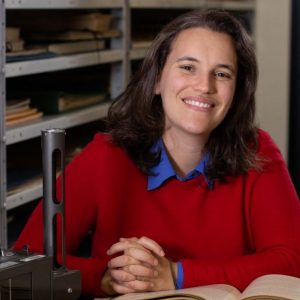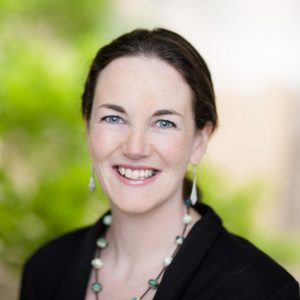
Dr Linden Ashcroft
School of Earth Sciences.
Email:
linden.ashcroft@unimelb.edu.au
- Historical atmospheric circulation in the Southern Hemisphere
- 19th century extreme rainfall and temperature events
- Climate variability and change in Australia and the Southern Hemisphere, including synoptic variability
- Climate data rescue and climate change communication

Prof Craig H Bishop
Room 449 McCoy Building.
Email:
craig.bishop@unimelb.edu.au
1. Improving climate projections of extremes using advanced ensemble post-processing techniques on CMIPx ensembles.
On average, in the summers of 2080-2100, how many days will Tmax exceed 35 C in Hobart/Melbourne/Perth/Adelaide/Sydney?
One relatively low cost and promising approach for attempting to narrow the uncertainty in answers to these questions is by assigning weights to CMIPx ensemble members based on their performance relative to historical observations and then using this weighted ensemble to make a prediction. A plausible measure of the extent to which this approach can reduce projection error can be obtained by replacing the actual observations by pseudo-observation counterparts from just one of the CMIPx projections. One can then test the ability of sub-ensembles (that do not include the member used for generating the obs) weighted using the historical pseudo-observations to predict future pseudo-observations (e.g. from 2080-2100). In this project, you will strive to improve ensemble weighting techniques and design relevant metrics of changes in extremes.
2. Estimation of observation error biases and error correlation
Currently, just a few percent of the hundreds of millions of observations taken by satellites are used for weather and climate forecasting. A primary reason for this is that many of these observations have errors whose biases and error correlations are poorly known. In this project, you will explore and discover new and more accurate methods of estimating observation error biases and correlations and hence enable the wealth of information in these observations to be used to create more accurate weather and climate prediction systems.
3. Assimilation of high-resolution satellite cloud imagery
Clouds and precipitation are primary sources of error in both weather and climate models. An extremely promising way of correcting these errors is to use advanced cloud observation assimilation techniques to define and correct these errors. Current cloud observation assimilation techniques are poorly equipped to do this because they do not account for the non-Gaussian nature of uncertainties or the strongly non-linear relationship between cloud, temperature and humidity. In this project, you will develop and test new algorithms for assimilation of high-resolution satellite cloud imagery such as that generated by the Himawari and Severi satellites.
4. Use of Machine Learning, Artificial Intelligence and High-Resolution simulation to improve coarse resolution models.
Clouds and precipitation are primary sources of error in both weather and climate models. Because climate models need to be run for hundreds of years, they are run at a much coarser resolution than the models used for short-term weather prediction. The coarseness of climate model resolution causes them to mis-represent climate critical processes like oceanic upwelling near coastlines and associated vast regions of high albedo low clouds that influence the total climate warming to increasing Greenhouse Gas emissions. Nevertheless, such processes are well represented by high resolution coupled weather forecast models. In this project, you will discover Machine learning methods to render coarse resolution models statistically indistinguishable from high resolution models filtered to the scale of the coarse resolution models.
5. Use of Machine Learning, Artificial Intelligence and Data Assimilation to improve parameterizations in high resolution models.
Even our highest-resolution models of the atmosphere and ocean require the simplified representation of “parameterization” of poorly resolved processes such as cloud particle formation, rain, turbulent mixing. Ideally, these parameterization schemes should be tuned to maximize the ability of the high resolution model to produce trajectories that are consistent with high spatio-temporal resolution observations. However, methods for doing this are in their infancy. In this project, you will build tools that enable the creation of Machine Learning based parameterizations that enable model trajectories that stay close to observations over much longer periods of time than those in current usage.
6. Assimilation of ice and chlorophyll observations into ocean models and coupled models
Forecasts and observations of ice and chlorophyll have highly asymmetric non-Gaussian uncertainty distributions and, in the case of ice, a strongly non-linear relationship with the temperature of the ocean. Current ocean data assimilation schemes do a poor job of accounting for such non-Gaussianity and non-linearity. In this project, you will discover and implement new methods for assimilating ice and chlorophyll observations and demonstrate their superiority to existing techniques.
7. PhD in Past Climate Reconstruction
The last decade has seen an explosion of research showing how corals and trees in both living and fossilized forms can be used to infer averages of the temperature and precipitation experienced while they were developing. These approaches provide proxy temperature and precipitation record dating back hundreds/thousands of years at locations where there were no temperature or precipitation observations made by humans. It is likely that more and more of these proxy temperature records will be discovered in the coming years at new locations. Each year more such proxy temperature and precipitation records are discovered. If selected, your PhD research will create new methods for finding the range of possible atmospheric and oceanic trajectories that are consistent with these observations. Your primary tool will be data assimilation methods which use climate models to optimally propagate and combine observational information that is distributed through space and time. A BSc (Hons) is a pre-requisite for the position. A major or minor in one or more of Applied Mathematics, Statistics and Physics would increase your chances of selection for the position.
8. Statistical corrections for improved week 3 prediction
Coupled models have known biases. Advanced statistical forecast models such as Linear Inverse Models (LIMs) have no bias when tested against historical data. Furthermore, while coupled models tend to under-persist larger scale modes associated with blocking, NAO. SAM, …, etc, LIMs persist such modes in accord with past behaviour. In this project, you will discover improved statistical models for predicting the errors in sub-seasonal forecast models and use them to improve week 3 predictions.
9. Event Attribution and Climate change
The climate is warming. Warmer air holds much more water vapour than colder air. Water vapour releases latent heat when it changes phase to form clouds of liquid and ice particles; consequently, warmer air provides cyclones with a greater reservoir of latent heat energy than colder air. On the other hand, the moist adiabats associated with warm surface air leave the post-convection atmosphere in a stabler state than the post-convective air associated with colder surface air.
To what extent are today’s extreme weather events made more extreme by the warmer background state?
To address this question, one would like to see how differently the precursors of today’s extreme weather events would subsequently evolve if they had been produced in the pre-industrial climate. Similarly, one would like to know how the precursors of extreme events in a pre-industrial climate would behave if they were produced in today’s climate. In this project, in collaboration with the Bureau of Meteorology, you will use advanced data assimilation tools to address this question.
10. Improving ocean data assimilation with Hybrid covariance models and vertical covariance localization
In the last decade. Hybrid forecast error covariance models that mix climatological covariances with ensemble-based flow dependent covariances, and vertical model space ensemble covariance localization have led to some of the biggest ever jumps in forecast skill at major weather prediction centres. In this project, working in collaboration with the Bureau of Meteorology, you will discover and understand how such changes would affect ocean forecasting accuracy.

Dr Josephine Brown
Email: josephine.brown@unimelb.edu.a
- Palaeoclimate modelling of the Australian region and comparison with proxy records
- Drivers of tropical rainfall variability in past and future climates
- The evolution of the Australian monsoon over the Holocene
- Using palaeoclimate simulations of past warm climates to understand future projections

Dr Yi Huang
Email: yi.huang4@unimelb.edu.au
- Clouds, Precipitation, and Boundary Layer Characteristics in Subantarctic Mesoscale Cyclones
- Coupling Cold Air Outbreaks (CAOs) and Extreme Weather in the Australian Region (with A/Prof Todd Lane)
- Informing Cloud Data Assimilation using High-resolution Cloud Observations (with Prof Craig Bishop)
- Cloud-aerosol Interactions over the Great Barrier Reef

Dr Andrew King
Email: andrew.king@unimelb.edu.au
- Seasonal prediction of climate extremes in Australia.
- Understanding global and regional patterns of climate change and climate extremes.
- The meteorological drivers of climate extremes and their changes under climate change and climate variability.

Dr Peter Rayner
Email: prayner@unimelb.edu.au
- Mapping Australia’s methane emissions using new satellite observations
- Improved modelling of the planetary boundary layer using measurements of Radon (partner with ANSTO)
- The interplay of the El Niño Southern Oscillation, atmospheric dynamics and the growth rate of atmospheric CO2 (partner with CSIRO)
- Green and grey cities, patterns and trends of fossil fuel emissions
in the world’s cities

Dr Robyn Schofield
Email: robyn.schofield@unimelb.edu.au
- Investigating how well climate models simulate urban air quality composition and change? (potential partners: CSIRO)
- Investigating the ability of fully coupled chemistry climate models to simulate Southern Hemispheric ozone changes and climate responses. (CSIRO)
- Investigating how weather and climate prediction models simulate aerosol at the complex air/sea/land interface (CSIRO, BoM)

Dr Claire Vincent
Email: Claire.vincent@unimelb.edu.au
- The role of surface and radiative fluxes in the timing of convection in the tropics and mid-latitudes: observations and models
- The MJO, mesoscale variability and extreme rainfall in Queensland
- Model representations of deep convection during the Years of the Maritime Continent Field campaign
A graduate research scholarship may provide a full fee offset for up to 2 years for students undertaking a Masters by research degree, and up to 4 years for students undertaking a Doctoral degree, plus a living allowance and relocation grant.
In addition, being part of the ARC Centre of Excellence for Climate Extremes provides a supportive environment for students, with a focus on increasing collaborative research through attendance at Centre and external events, and travel support for PhD students to visit our international partners and Centre meetings. Most projects involve other universities, the CSIRO, the Bureau of Meteorology, or one of our international partners.
To meet the University’s internal deadline, we suggest that expression of interest be submitted by Monday, 13th September 2021. The full application must be submitted by October 31, 2021 for domestic students (Australians or NZ citizens or Australian permanent residents) and September 30, 2021, for international students.
If you are interested in applying, please contact one of the potential supervisors, and along with your research interest area, provide a brief CV and copies of your academic results.
